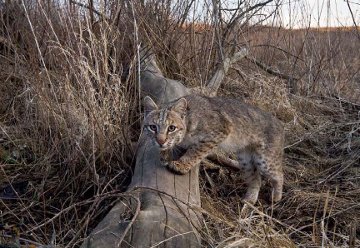Up-close and personal with a bobcat

Ever wondered about the techniques the pros use to produce such seemingly impossible images as the one above?
In a recent article for the Omaha World-Herald staff writer Rick Ruggles offers some insights into those used by Michael Forsberg, author of the new book Great Plains: America’s Lingering Wild—a fascinating photographic journey through some of the last remaining natural landscapes of the Great Plains.
In his new book, Forsberg—whose work has also appeared in such publications as Audubon, National Geographic, Natural History, and National Wildlife—has captured a number of amazing images of natural landscapes and wildlife. But as the World-Herald article reveals, the intimacy with which Forsberg is able to approach his subject matter is, perhaps ironically, due to the fact that much of the time, he’s not even there when the shutter opens. As Ruggles writes:
Wildlife photographers like Michael Forsberg, who just published the book Great Plains: America’s Lingering Wild, now have the ability to capture close-ups of wary creatures that can hear or sniff out a person from hundreds of yards away.
Forsberg intended to deploy that strategy this bright-blue October day just west of the headquarters of the National Audubon Society’s Rowe Sanctuary. The sanctuary is known as one of the finest spots from which to view the sandhill crane migration in March.
Forsberg, 43, looked for a place to assemble a “camera trap,” which includes two small devices with an infrared beam running from one, the transmitter, to the other, the receiver. The photographer also sets out a camera and lights, or flashes.
A predator that steps through the invisible red beam triggers the camera, which in turn triggers the flashes. Forsberg can be far away, eating dinner with his wife and two daughters in Lincoln or photographing swans in the Sand Hills, when the image he covets is captured.
Continue reading about Forsberg’s photographic techniques at the Omaha World-Herald or to preview some of its results, check out our online gallery of images from the book, and these sample pages in PDF format.